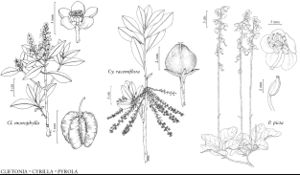Pyrola
Sp. Pl. 1: 396. 1753.
Gen. Pl. ed. 5, 188. 1754 ,.
Herbs, chlorophyllous, autotrophic (achlorophyllous and heterotrophic in forms of P. chlorantha and P. picta). Stems erect, glabrous. Leaves essentially basal or, sometimes, highly reduced or absent (P. chlorantha, P. picta), alternate; petiole present; blade maculate or not, elliptic, ovate-elliptic, oblong-elliptic, oblanceolate, oblong-obovate, ovate, obovate, spatulate, subreniform, reniform, or round, subcoriaceous to coriaceous, margins entire, denticulate, crenulate, crenate, or crenate-serrulate, plane or revolute, surfaces glabrous. Inflorescences racemes, usually erect in flower and fruit, (symmetric); peduncular bracts present or absent; inflorescence bracts free from pedicels. Pedicels pendent in fruit; bracteoles absent. Flowers radially symmetric (bilaterally symmetric in P. minor), spreading or nodding; sepals 5, connate proximally, often obscurely so, calyx lobes lanceolate, ovate, triangular, deltate, oblong, or obovate; petals 5, distinct, white, greenish white, yellowish white, pink, or purplish red, without basal tubercles, corolla crateriform to broadly campanulate; intrastaminal nectary disc absent; stamens 10, exserted; filaments broad proximally, gradually narrowed medially, slender distally, glabrous; anthers oblong, without awns, with or without tubules, dehiscent by 2 round to elliptic or obovate pores; pistil 5-carpellate; ovary imperfectly 5-locular; placentation intruded-parietal; style (exserted or included), bent downward or straight (P. minor), expanded distally; stigma 5-lobed, without subtending ring of hairs. Fruits capsular, pendulous, dehiscence loculicidal, cobwebby tissue exposed by splitting valves at dehiscence. Seeds ca. 1000, fusiform, winged. x = 23.
Distribution
North America, Mexico, Central America (Guatemala), Europe, Asia (including Sumatra).
Discussion
Species ca. 30 (7 in the flora).
The apparent absence of strong genetic discontinuities within many species complexes, as well as morphologic and cytologic uniformity, have challenged attempts to delimit species in Pyrola. Chromosome counts for all species are diploid (2n = 46) except for the boreal European species P. media, which is a tetraploid (2n = 92), and some triploid counts (2n = 69) for P. grandiflora. Natural hybrids have been reported widely. Some species complexes have been examined in detail; a modern, comprehensive monograph of the genus is needed. Of particular interest in the flora area are relationships among members of sect. Pyrola, which includes, among other species, North American P. americana, amphi-Pacific P. asarifolia, arctic and circumpolar P. grandiflora, and Eurasian P. rotundifolia Linnaeus. J. V. Freudenstein (1999b) found limited cladistic structure in Pyrola. Morphologic and molecular data support a clade comprising P. chlorantha and P. picta (including P. aphylla). Molecular data suggest that this clade is sister to one comprising P. elliptica and P. minor.
Pyrola americana, P. asarifolia, P. chlorantha, P. elliptica, and P. picta have a variety of drug, food, and ceremonial uses among a dozen tribes of Native Americans (D. E. Moerman 1998).
Selected References
Lower Taxa
Key
| 1 | Styles (0.5-)0.8-1.5(-1.8) mm, included, straight; anthers 0.8-1.4 mm, tubules absent; flowers radially symmetric. | Pyrola minor |
| 1 | Styles 4-10 mm, exserted, bent downward; anthers (1.6-)2.2-5.5 mm, tubules present; flowers bilaterally symmetric | > 2 |
| 2 | Inflorescence bracts as long as or longer than subtended pedicels (sometimes shorter than subtended pedicels in P. asarifolia subsp. asarifolia); calyx lobes longer than wide | > 3 |
| 2 | Inflorescence bracts usually shorter than subtended pedicels, rarely longer than subtended pedicels; calyx lobes ± as long as wide | > 5 |
| 3 | Filament bases 0.2-0.3 mm wide; anther apiculations absent or less than 0.1 mm, thecae creamy yellow to golden yellow, tubules yellow to yellowish brown. | Pyrola grandiflora |
| 3 | Filament bases 0.5-1.1 mm wide; anther apiculations 0.1-0.5(-0.7) mm, thecae creamy white, greenish white, tan, pink, reddish, dark purple, or yellowish, tubules yellowish brown, orange, pink, reddish, or dark purple | > 4 |
| 4 | Calyx lobes ovate, ovate-oblong, or obovate, apices obtuse to acute; petals white, often suffused with pink. | Pyrola americana |
| 4 | Calyx lobes triangular, apices acute to acuminate; petals white proximally and pinkish distally, or pink to purplish red throughout | Pyrola asarifolia |
| 5 | Anther tubules abruptly narrowed from thecae, lateral walls not touching or connivent distally, 0.7-1.1 mm; calyx lobe apices acute to obtuse. | Pyrola chlorantha |
| 5 | Anther tubules gradually narrowed (at least when viewed laterally) from thecae, lateral walls touching for most of their lengths or connivent distally, 0.3-0.8 mm; calyx lobe apices acute to acuminate | > 6 |
| 6 | Leaf blades not maculate or, rarely, maculate, broadly elliptic to oblong or oblong-obovate, margins crenulate or obscurely denticulate; petals white to greenish white; apices of calyx lobes acute to short-acuminate. | Pyrola elliptica |
| 6 | Leaf blades usually maculate, sometimes not maculate, ovate or ovate-elliptic to oblanceolate or spatulate, margins entire or denticulate to coarsely denticulate, or plants leafless; petals greenish white, white, pink, or reddish; apices of calyx lobes acute. | Pyrola picta |
